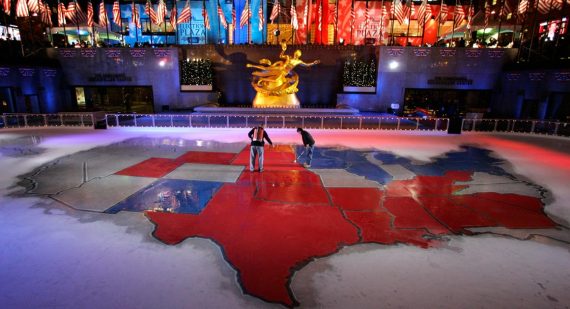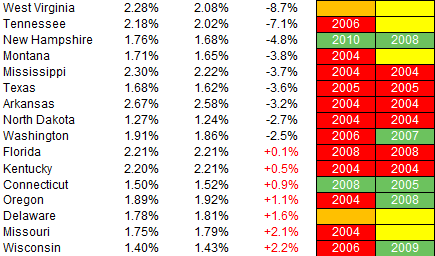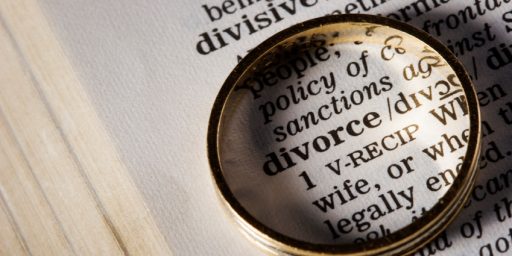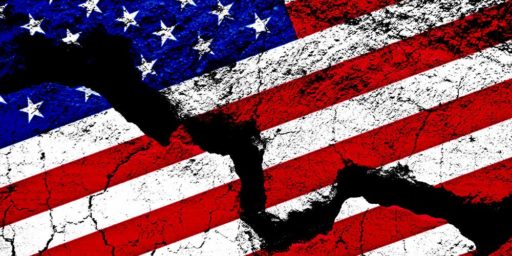Another Reason to Dislike the Electoral College
"Red States" and "Blue State"

James Joyner’s post about MTG’s “national divorce” rhetoric makes me want to point out that the entire rhetoric over “red states” and “blue states” is almost entirely an artifact of the Electoral College. Indeed, it is specifically the marriage of choosing electors in plurality contests by state coupled with television that gives us the entire notion.
The fact that we elect the Electoral College in multi-seat districts (states) with plurality winners (with some variation in Maine and Nebraska) means that each state goes, as a unit, to one party or the other. It doesn’t matter that over a third of voters in California in 2020 were Republican, the state turned blue on TV, so blue it is. So what if 49ish% of Pennsylvania are Republicans?
To me this underscores how institutional structures can shape the way we think about ourselves. I recognize the states as political units have a deep significance in US political development, but nothing makes us think in terms of states as uniform political units the way the Electoral College (as augmented by TV) does.
We allow the simplicity of the map to shape our thinking and to, in turn, make our political discourse more simplistic.
We allow the idea that a state is blue to erase all the Republicans from our minds and likewise the red ones ignore all the Democrats. This just makes polarization easier and more pernicious.
As is often noted, all states are really some shade of purple (if we must think in terms of colors). More importantly, as I frequently note, states are just lines on the map, and largely arbitrary ones at that. States are important because they contain people. And the focus on Red States and Blues States makes us forget that we are really talking about citizens, not real estate.
It worth noting that the notion that red meant Republican and blue meant Democrat only started as result of the 2000 election. Heck, the networks have only colored in the states since 1976. See this 2014 NPR piece for some background: The Color Of Politics: How Did Red And Blue States Come To Be?
Side note: the utter insanity of MTG’s position is massive, but it is amusing to note that by the logic of the Electoral College, Georgia is currently a “blue state” and under her own “national divorce” scenario she would have to live in Wokeistan.





Thanks again for making this clear. For the benefit of a chemo brained Luddite, how exactly do we fire (or retire) the EC?
@Flat Earth Luddite: Unfortunately, it would take a constitutional amendment, which is unlikely to happen as long as one party knows that the EC helps them out more than it does their rival.
One imaginative idea I’ve read for dealing with the disconnect between the EC and today’s reality is this: Congress passes a law giving each congressional district 3 electoral votes, to be apportioned according to the overall vote in each congressional election (majority party gets 2 votes, minority party gets 1 vote). It might mitigate some of the damage the EC does to our national politics.
What’s interesting to me is that this terminology arose right at the time the modern polarization began, and we didn’t know at the time that it would be sustained. From the 2000 election forward, all but 15 states have voted for the same party in every presidential election. This is fundamentally different than the way it was during most of the 20th century, when the states routinely made wild swings from one election to the next, so that every state was at least potentially up for grabs. The current situation where the candidates ignore all but a handful of states is very much a modern phenomenon. Most 20th-century elections were landslides of some form, but even the close elections of the past had a much wider range of states considered battlegrounds than would be the case today. I’d say there were eight in 2020 (WI, MI, PA, FL, GA, NC, AZ, NV). In historical nail-biters like 1960, 1976, or 2000, it was more in the territory of 20.
Yes, this was even true in 2000, which as mentioned was when the whole red/blue business started. Before the election, a lot of pundits thought there might be a split between the popular vote and electoral college–however, most predicted it would involve Bush winning the PV and Gore winning the EC. Why did they think that? Because most of the polls showed Bush with a narrow but consistent lead in the PV. Yet the state polls were totally inscrutable–more than a dozen states were judged toss-ups by pollsters, and a bunch more leaned toward one candidate or the other but only slightly. That was the last election when that happened. Some of the specific states considered battlegrounds have changed throughout this century so far, but in any election it’s always a much smaller number of states than was the case just a few decades ago.
That’s why our coining the terms “red state” and “blue state” in 2000 was somewhat prophetic, as these were terms that would become increasingly relevant over time. Regardless of which colors apply to which party, these terms imply some level of permanent, or at least long-lasting, allegiance. In the 1980s we might have described, say, Maryland as a Democratic-leaning state, but that didn’t mean it was out of reach to Republicans. When we call Maryland a “blue state” today–or Oklahoma a red state–we do mean it’s completely out of reach to the other party. That’s a very modern way of looking at things. It wasn’t always this way.
This obviously has made the EC problem worse, because it contributes greatly to the problem we talk about where in the vast majority of states your vote effectively doesn’t matter in presidential elections. There was always an element of that, but it’s greatly increased in the modern age.
I’m not sure whether that’s true. Not long ago I was watching recordings of historical Election Night broadcasts on Youtube, and I saw one from 1968, where they did in fact color states on the election map (and it was three colors that year because of George Wallace), though they were careful to choose colors that were distinguishable on black-and-white TV sets.
My 7th-grade social studies teacher taught us about the EC as a random impossible factoid, as in: “Get this: you could win the popular vote but lose the presidency.” This was in the late 80s. And I remember during the last days of the 2000 election there was talk about Bush winning the popular and losing the EC, and how this would be a grave error which would quickly be remedied.
Had that happened, I’m guessing we would a completely understand ‘history’ of the EC which would end in 2000 after its flaws were revealed. Instead, we have brainwashed Republicans swearing fealty to something that was treated as a historical artifact until they started needing it to win.
This is my nightmare scenario. Winner take all is not a given. Nebraska and Maine are insignificant factors in the Electoral College. The what if factor is this. What if a purple state is temporarily controlled by one party who then changes the electoral vote to proportional allocation. It will create even more chaos as some states are winner take all and some are proportional. One party could potentially take controlled of the Presidency as a permanently minority party (close to what it is now). Not a good scenario.
Not a cure, but could somewhat ameliorate by increasing the size of the House of Representatives, which we should anyway, currently way too many people per district.
@Modulo Myself:
I’m not persuaded that it would have been remedied at all, let along quickly. The Democrats wouldn’t have been likely to embrace a popular vote election in a period where their candidate had just won by EC majority* and even if they’d been willing, the Constitutional amendment process would have taken years, if it ever passed.
*To the extent that I recall, this was still part of the era where the “permanent conservative majority” was still at least a lingering fear.
@charon: That would reduce the damage, but not by much. Currently, WY has ~3.5x the power of CA in the EC – that is, by population, there’s a EV for each 200,000 Wyoming residents vs every 700,000 in California. In order to get down to 2:1, you would need a rep for every 200,000 people – that’s 1600+ representatives. And you would still have every person in Wyoming casting a ballot that’s 2x as potent as each person in California (assuming winner-takes-all).
This lasting inequity is surreal, mostly because statistically you would have expected a lot more bad outcomes. Even at the time of the founding, Delaware was almost 4x as powerful as Virginia – 1 EV per 20,000 people vs 1 EV per 75,000 people. (Of course, if you restrict it to just vote-eligible people, the ratio drops to – 1/4,000 vs 1/11,000, so under 3:1.)
All this is to say, enlarging the House is good on paper but will not really change much unless it’s enlarged to a comical degree.
And yes, the permanent conservative majority looks pretty healthy even still.
@Scott: And note that using the district method (e.g., Nebraska and Maine) is not proportional distribution of the EVs (although it is sometimes called that). It would mean that it would be possible to gerrymander the EC.
@Steven L. Taylor:
This isn’t even hypothetical. After Obama flipped NE-2 in 2008, the Nebraska legislature redrew the district to make it harder for Dems to win.
It’s not so much red vs. blue as city mouse vs. country mouse. Houston is not a GOP stronghold. Nor are San Antonio and Austin. Even Dallas is blue. What if Texas were to vote to secede and the biggest cities all said, ‘Nope.’
I think a trial separation is in order. Let’s start with Florida and see if we can live without them. Alabama and Mississippi are too obvious – of course we can live without them, the educational level and per capita GDP of the United States would leap upward. But let’s make it a little tougher and invite Florida to fuck off. Before hurricane season would be nice.
Or, the three west coast states could petition to join Canada. New England as well. Can’t imagine Canadians would like the idea much, but it would be great for California. Imagine the tariffs we could collect on shipping to the far east. I can start calling people fella instead of dude, I’m ready for that sacrifice.
@Michael Reynolds:
Wait? you talk to people? In person? I thought you just grimly smouldered at people until they got nervous and did something, anything, they thought would please you.
@Beth:
Well, sure, that’s a given. But occasionally I interact with the DoorDash drivers when they bring me my Tikka and Naan, and it’s not like I’m going to use their actual names. Or allow them to meet my gaze.
@ptfe: You are correct, and it frustrates me to no end that liberals and progressives simply concede these “high value” states rather than make a play for them. There is nothing in the modern Republican Party that should appeal to the West and the Midwest states. The party as it stands today is a buzzing swarm of angry busybodies sticking their nose into everyone’s business all the time, following people into the bathrooms to get a look at their junk and checking out their underwear drawers for transgressions. They are also obscenely obsessed with class and hierarchy and keeping everyone in their place. And finally, they are also a fear based party, constantly and hysterically afraid of everyone and everything. Those are not Midwestern or Western values.
@Michael Reynolds:
Indeed. But nonetheless, Texas is a “Red State” for the reasons I note.
@Steven L. Taylor: Interesting side note that cities in blue states are blue, and cities in red states are also blue. If California were seceding we’d lose Bakersfield and little else. Texas, Georgia, North Carolina, they’d lose every one of their major cities.